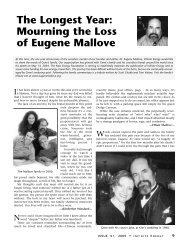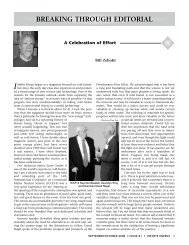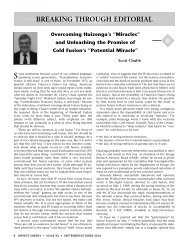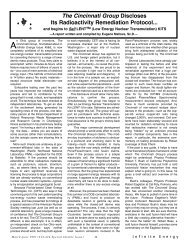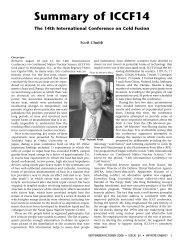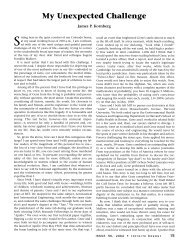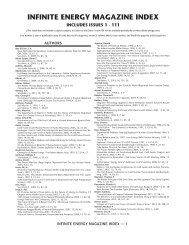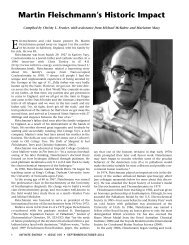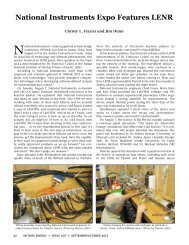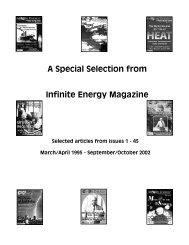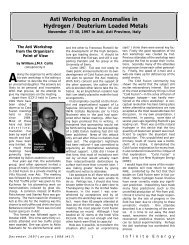MIT and Cold Fusion: A Special Report - Infinite Energy Magazine
MIT and Cold Fusion: A Special Report - Infinite Energy Magazine
MIT and Cold Fusion: A Special Report - Infinite Energy Magazine
You also want an ePaper? Increase the reach of your titles
YUMPU automatically turns print PDFs into web optimized ePapers that Google loves.
e seen in several reviews <strong>and</strong> compilations of many experiments:<br />
* Edmund Storms (Los Alamos National Laboratory), “Review of<br />
Experimental Observations About the <strong>Cold</strong> <strong>Fusion</strong> Effect,” accepted for<br />
publication in <strong>Fusion</strong> Technology, 1991.<br />
* M. Srinivasan (Bhabha Atomic Research Centre), “Nuclear <strong>Fusion</strong> in<br />
an Atomic Lattice: Update on the International Status of <strong>Cold</strong> <strong>Fusion</strong><br />
Research,” Current Science, 25 April 1991.<br />
* Steven E. Jones, Franco Scaramuzzi, <strong>and</strong> David Worledge (editors),<br />
Anomalous Nuclear Effects in Deuterium/Solid Systems, American<br />
Institute of Physics Conference Proceedings 228, 1991.<br />
* Investigation of <strong>Cold</strong> <strong>Fusion</strong> Phenomena in Deuterated Metals (four volumes),<br />
by the National <strong>Cold</strong> <strong>Fusion</strong> Institute, June 1991, now available from NTIS.<br />
What is most disturbing, however, about the way in which the <strong>MIT</strong><br />
research was conducted was the arrogant dismissal of the work of other<br />
scientists with the group’s insubstantial, manipulated, <strong>and</strong> flawed evidence.<br />
It smacks of a rush to judgement by a group that had made up its<br />
mind that it would never find anything positive nor would it report<br />
such. Even before they had completed their experiments, members of<br />
the <strong>MIT</strong> group made it quite clear to the world in so many ways that<br />
they didn’t expect to find anything. The parallel effort to discredit the<br />
motives of other scientists <strong>and</strong> the denial that such an effort was ever<br />
made has had a lasting corrosive effect on the entire field. I hope that<br />
when the inquiry <strong>and</strong> expected investigation of this matter is completed,<br />
<strong>MIT</strong> will adopt guidelines to insure that this behavior is never repeated.<br />
Sincerely, Eugene F. Mallove<br />
List of Attachments (those with * can be found in this issue)<br />
1. Plasma <strong>Fusion</strong> Center <strong>Report</strong>, PFC/JA-89-34, “Measurement <strong>and</strong> Analysis of<br />
Neutron <strong>and</strong> Gamma Ray Emission Rates, Other <strong>Fusion</strong> Products, <strong>and</strong> Power in<br />
Electrochemical Cells Having Pd Cathodes”<br />
2. The corresponding paper in the Journal of <strong>Fusion</strong> <strong>Energy</strong>, Vol.9, No.2, 1990,<br />
pp.133-148.<br />
*3. Four figures, two of which were obtained from the <strong>MIT</strong> team’s draft material<br />
<strong>and</strong> two of which were published. These have been adjusted in size by me from<br />
their original form for easier comparison.<br />
4. Draft report of calorimetry section, July 13, 1989.<br />
5. Draft report of calorimetry section, July 10, 1989.<br />
*6. Letter from Professor Ronald R. Parker to Eugene Mallove, August 8, 1991.<br />
*7. Letter to Dr. Stanley C. Luckhardt from Eugene Mallove, April 29, 1991.<br />
8. A technical letter to the editor in <strong>Fusion</strong> Technology , Vol. 19, May 1991, pp. 579-580.<br />
*9. Letter to Dr. Vesco C. Noninski from Professor Mark S. Wrighton, October 10,<br />
1990.<br />
*10. Letter (June 14, 1991) from Eugene Mallove to Professor Ronald R. Parker,<br />
requesting data that was promised at an open public meeting.<br />
*11. Letter to Professor Parker from Eugene Mallove, July 30, 1991.<br />
*12. Letter to Eugene Mallove from Professor Parker, August 13, 1991.<br />
*13. <strong>MIT</strong> News Office press release, May 1, 1989.<br />
*14. Partial transcript of April 28, 1989 interview by Boston Herald reporter Nick<br />
Tate with Professor Ronald R. Parker <strong>and</strong> Associate Professor Ronald Ballinger.<br />
*15. Transcript of David Baron’s WBUR radio program (August 9, 1991) about the<br />
cold fusion controversy.<br />
*16. Letter from Richard Saltus of the Boston Globe (April 17, 1989) to President<br />
Paul E. Gray.<br />
*17. Letter from President Paul E. Gray to Richard Saltus (May 1, 1989).<br />
Exhibit S<br />
Permission Given to Transmit Request to Dr. Vest<br />
September 9, 1991<br />
It was necessary for Dr. Rowe to have my formal permission to<br />
submit my request for an investigation to President Vest.—EFM<br />
Dr. Eugene F. Mallove<br />
The Writing program, 14N-316, Department of Humanities<br />
Massachusetts Institute of Technology<br />
Dr. Mary P. Rowe<br />
<strong>Special</strong> Assistant to the President, Room 10-213<br />
Massachusetts Institute of Technology<br />
Dear Dr. Rowe:<br />
As per our telephone conversation of last week <strong>and</strong> earlier telephone<br />
message exchanges, I agree with you that my formal request for an<br />
inquiry <strong>and</strong> investigation of possible scientific misconduct at <strong>MIT</strong> (letter<br />
<strong>and</strong> attachments dated August 18, 1991) should be redirected by<br />
your office to President Vest. Though I am assuming that you have<br />
already made this transfer, I hereby formally give you permission to<br />
direct the request to Dr. Vest.<br />
Sincerely, Eugene F. Mallove<br />
Exhibit T<br />
Eugene Mallove's Response to a Statement on <strong>Cold</strong> <strong>Fusion</strong><br />
Issued by the <strong>MIT</strong> News Office 8/30/91<br />
Received by Mallove only on 9/16/91<br />
The <strong>MIT</strong> PFC had put out an outrageous “Press Release” on<br />
August 30, 1991, which I did not get wind of until mid-September.<br />
Here is my rebuttal of its various claims. —EFM<br />
Dr. Eugene F. Mallove<br />
Bow, New Hampshire, September 17, 1991<br />
On August 30, 1991, the <strong>MIT</strong> News Office issued a disgraceful<br />
<strong>and</strong> misleading statement about the cold fusion controversy<br />
(see attached). What follows is my point-by-point response to<br />
this statement. Bold type are quotations from the August 30,<br />
1991 <strong>MIT</strong> News Office statement.<br />
• “<strong>MIT</strong> scientists intensely investigated the phenomenon called ‘cold<br />
fusion’ for two months in 1989. Like other scientists around the<br />
world, they were unable to duplicate the Pons <strong>and</strong> Fleischmann<br />
experiment They have concluded that, while the reaction termed<br />
cold fusion is scientifically interesting, it is not one which is valuable<br />
for them to pursue at this time.”<br />
Note the implication that all scientists at <strong>MIT</strong> who had anything<br />
to do with cold fusion investigated it for only two months<br />
<strong>and</strong> then dropped it after being unable to duplicate the Pons <strong>and</strong><br />
Fleischmann experiment. This is not true. To my knowledge, at<br />
least five <strong>MIT</strong> professors continue to be actively interested in<br />
cold fusion experiments <strong>and</strong> theories. Numerous other professors,<br />
researchers, <strong>and</strong> students at <strong>MIT</strong>, not directly engaged in<br />
cold fusion, have expressed intense curiosity about the status of<br />
current cold fusion research. At least two <strong>MIT</strong> professors have<br />
applied for patents on cold fusion concepts. The cold fusion theory<br />
of one <strong>MIT</strong> professor is highly regarded in the field. Moreover,<br />
cold fusion research is right now being actively pursued at<br />
dozens of laboratories in the U.S. <strong>and</strong> abroad.<br />
I challenge the term “intensely investigated for two months.”<br />
The <strong>MIT</strong> professors who influenced this statement arrogantly<br />
suggest that it is possible to perform two months of experiments<br />
<strong>and</strong> come to definitive conclusions about so difficult a<br />
phenomenon as cold fusion. They are wrong about this <strong>and</strong><br />
they know it, as the phrase “scientifically interesting” so clearly<br />
reveals. The preparers of this statement are well aware that they<br />
do not underst<strong>and</strong> this “scientifically interesting reaction,” nor<br />
is it likely that they have they kept current on what is really<br />
happening in this field, yet they claim to be able to determine<br />
that “it is not one which is valuable for them to pursue at this<br />
time.” This is an indictment of the appalling lack of scientific<br />
curiosity manifested by these individuals. If this is supposed to<br />
be an example to <strong>MIT</strong> students about how deeply scientific<br />
curiosity should be followed, the Institute is in grave trouble.<br />
The statement also incorrectly implies that other scientists<br />
have not been able to duplicate the Pons Fleischmann experiment.<br />
The phrase used was, “like other scientists around the<br />
world.” Again, the statement preparers are engaging in smokescreen<br />
tactics. Numerous other investigators have to their own<br />
satisfaction <strong>and</strong> to the satisfaction of other objective evaluators<br />
replicated cold fusion phenomena, including excess energy evolution<br />
in excess of what can be explained by conventionally<br />
understood chemical or mechanical energy release, the production<br />
of tritium, the production of neutron bursts, low-level neutron<br />
emissions, <strong>and</strong> charged particle emissions.<br />
• “They note that the University of Utah, where ‘cold fusion’<br />
45 <strong>Infinite</strong> <strong>Energy</strong> • ISSUE 24, 1999 • <strong>MIT</strong> <strong>Special</strong> <strong>Report</strong>



